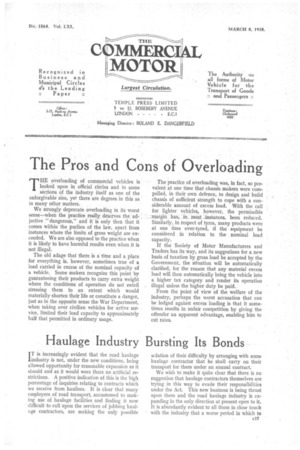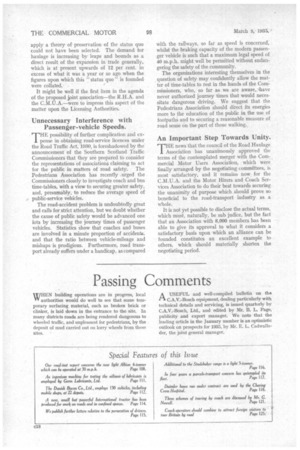Haulage Industry Bursting Its Bonds
Page 39

Page 40

If you've noticed an error in this article please click here to report it so we can fix it.
IT is increasingly evident that the road haulage industry is not, under the new conditions, being allowed opportunity for reasonable expansion as it should and as it would were there no artificial restrictions. A positive indication of this is the high percentage of inquiries relating to contracts which we receive from hauliers. It is clear that many employers of road transport, accustomed to making use of haulage facilities and finding it now difficult to call upon the services of jobbing haulage contractors, are seeking the only possible solution of their difficulty by arranging with some haulage contractor that he shall carry on their transport for them under an annual contract.
We wish to make it quite clear that there is no suggestion that haulage contractors themselves are trying in this way to evade their responsibilities under the Act. This new business is being thrust upon them and the road haulage industry is expanding in the only direction at present open to it. It is abundantly evident to all those in close touch with the industry that a worse period in which to apply a theory of preservation of the status quo could not have been selected. The demand for haulage is increasing by leaps and bounds as a direct result of the expansion in trade generally, which is at present upwards of 12 per cent, in excess of what it was a year or so ago when the figures upon which this `.` status quo" is founded• were collated.
It might be well if the first item in the agenda of the proposed joint association—the R.H.A. and the C.M.U.A.—were to impress this aspect of the matter upon the Licensing Authorities.
Unnecessary Interference with Passenger-vehicle Speeds.
THE possibility of further complication and expense in obtaining road-service licences under the Road Traffic Act, 1930, is foreshadowed by the announcement of the Southern Scotland Traffic Commissioners that they are prepared to consider the representations of associations claiming to act for the public in matters of road safety. The Pedestrians Association has recently -urged the Commissioners closely to investigate coach and bus time-tables, with a view to securing greater safety, and, presumably, to reduce the average speed of public-service vehicles.
The road-accident problem is undoubtedly great and calls for strict attention, but we doubt whether the cause of public safety would be advanced one iota by increasing the journey times of passenger vehicles. Statistics show that coaches and buses are involved in a minute proportion of accidents, and that the ratio between vehicle-mileage and mishaps is prodigious. Furthermore, road transport already suffers under a handicap, as compared with the railways, so far as speed is concerned, whilst the braking capacity of the modern passenger vehicle is such that a maximum legal speed of 40 m.p.h. might well be permitted without endangering the safety of the community.
The organizations interesting themselves in the question of safety may confidently allow the matter of time-tables to rest in the hands of the Commissioners, who, so far as we are aware, have never authorized journey times that would necessitate dangerous driving. We suggest that the Pedestrians Association should direct its energies more to the education of the public in the use of footpaths and to securing a reasonable measure of road sense on the part of those walking.,
An Important Step Towards Unity.
THE news that the council of the Road Haulage Association has unanimously approved the terms of the contemplated merger with the Commercial Motor Users Association, which were finally arranged by the negotiating committees, is most satisfactory, and it remains now, for the C.M.U.A. and the Motor Hirers and Coach Services Association to do their best towards securing the unanimity of purpose which should prove so beneficial to the road-transport industry as a whole.
It is not yet possible to disclose the actual terms, which must, naturally, be sub judice, but the fact that an Association with 8,000 members has been able to give its approval to what it considers a satisfactory basis upon which an alliance can be founded constitutes an excellent example to others, which should materially shorten the negotiating period.














































































































